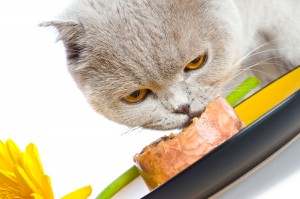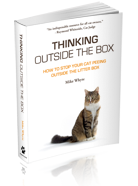 This is an interesting article on the topic of whether to feed your cat canned or dry food. I have recently been researching the subject myself and to my surprise found that the experts seem to be saying that you should be feeding your cat canned food exclusively. I’ve always been under the impression that a dry food diet was good for your pet, because it promotes healthy teeth and gums. The experts are now saying that cats don’t drink the water needed to sufficiently keep their bodies hydrated and that a diet consisting of all canned food would provide your cat the proper hydration needed for optimal health.
This is an interesting article on the topic of whether to feed your cat canned or dry food. I have recently been researching the subject myself and to my surprise found that the experts seem to be saying that you should be feeding your cat canned food exclusively. I’ve always been under the impression that a dry food diet was good for your pet, because it promotes healthy teeth and gums. The experts are now saying that cats don’t drink the water needed to sufficiently keep their bodies hydrated and that a diet consisting of all canned food would provide your cat the proper hydration needed for optimal health.
What You Should Feed Your Cat
by Monica E SaloisVeterinarians say that cats can live up to 30 years on a natural diet, but most domestic cats only live for 14 to 18 years on average. Why is that? The difference has a lot to do with diet.
Dry cat food has been found by the American Veterinary Medical Association to be less nutritious than canned food. There are several major reasons why dry food is not as good for most cats:
1. The main, and sometimes only source of protein, is usually from animal by-products, which is not the best quality. These are the parts of dead animals considered unfit for human consumption such as feet, intestines, feathers, pieces of fur, egg shells, and sometimes even include organs from diseased animals.
2. They actually contain an insufficient amount of animal based protein most of the time compared to the vegetable protein content. Most dry cat food consists of vegetable based meal flavored with meat flavorings and it usually has a high gluten content. As with humans, there are many cats that are allergic to gluten.
3. Most dry cat foods contain too much starch, or carbohydrate. Cats are pure carnivores that do not need, nor thrive on, the excessive carbohydrate based formulas commercially available. The average dry food contains from 35% to 50% carbohydrates and some of the cheaper brands contain even higher levels. Cats simply have no dietary need for high carbohydrates and food with too much starch can actually be very detrimental to their health.
4. Cats sometime do not drink enough water to compensate for the lack of moisture in their dry food. Insufficient fluid from their food source can cause bladder infections and kidney stones. This is why it is so important to always serve fresh water with any form of dry cat food. Be careful not to give them milk once they have reached adulthood. Most cats become lactose intollerant as they age and milk gives them diarrhea. They may like it and drink it, but it has no nutritional value for them. It is better to use a milk substitute if they like the taste, such as Cat’s Sip, or something similar.
5. Most brands of dry cat food use unhealthy preservatives such as BHT, BHA, and ethoxyguin to prolong shelf life. Generally, BHA is used to keep fats from turning rancid and it is also used as a yeast de-foaming agent. BHT also prevents oxidative rancidity of fats and is often used to preserve food odor, color, and flavor. Preservatives that prolong shelf life of a product are not healthy for any living creature.
6. Most dry cat food loses nutrient value due to the long cooking times used in their processing, and very high temperatures. Dry cat foods tend to be little more than non-nutritious, flavored bulk meal.
7. The dry food formulas that contain oils can often become rancid over time when stored on warehouse and supermarket shelves. Generally, most cats refuse to eat rancid food and it can make them ill.
8. Some dry cat foods often contain a life-threatening and extremely dangerous fungal toxin caused during transportation or storage, and this can poison your cat.
In the wild, a cat will eat high protein, high moisture foods, mostly from meat-based sources such as mice, moles, bats, rats, small birds, insects, worms, slugs, and small snakes. Only 3% to 5% of a cat’s natural diet contains starch, or carbohydrate. On occasion, cats will eat grass because the enzymes aid in digestion and are a natural laxative. Overall, mice are the best form of food for cats because they have muscle meat, pre-digested stomach contents, calcium from the bones, and moisture from the fluids.
The next best form of food for domestic cats is canned or frozen food with a strong content of animal or fish protein, mostly from muscle meat, not organ meat, such as liver; nor from any animal by-products. Good quality canned cat food should not contain any “meal” or “grains” either. Fat, and some organ meats such as liver and heart, are good for flavoring, but they should not be the main ingredient. Never use any cat food that contains soy, wheat, corn, or yeast. If it does contain a grain, then rice is the safest for cats.
Although cats are carnivores, they can’t survive purely on meat alone. Quality cat food should contain supplements such as oils, vitamins, and minerals. Cats should be fed fish at least once a week, such as canned tuna, cod, or salmon. Cats will also eat spam, ham, raw hamburger, hotdog wieners, and any form of beef, chicken, turkey, and most lunchmeats and cold-cuts. It is good to give your cat a treat once in awhile such as “Temptations”, but don’t let them make a meal out of them or demand them excessively. They are high calorie, dry snacks not intended for meal substitutes. When serving a canned meat, the patte kinds are generally the best because the cat will lick the gravy off the other varieties and leave the meat to spoil. When the cat doesn’t eat it, the owner generally throws it out, which is very wasteful.
Article Source: EzineArticles.com
I currently feed my cats both canned and dry food, but after reading this article, it may be a good idea to transition my kitties onto a diet consisting of all canned food. I have one cat who eats dry food only and will not touch the wet stuff, which is going to be quite a challange making the switch. I found a few sites with recipes for making homemade wet cat food which I’m considering adopting in the future. Hopefully these recipes will help me get my all kibble eating addicts to switch to wet food exclusively.

Please contribute to this article discussion and post a comment below...
Powered by Facebook Comments